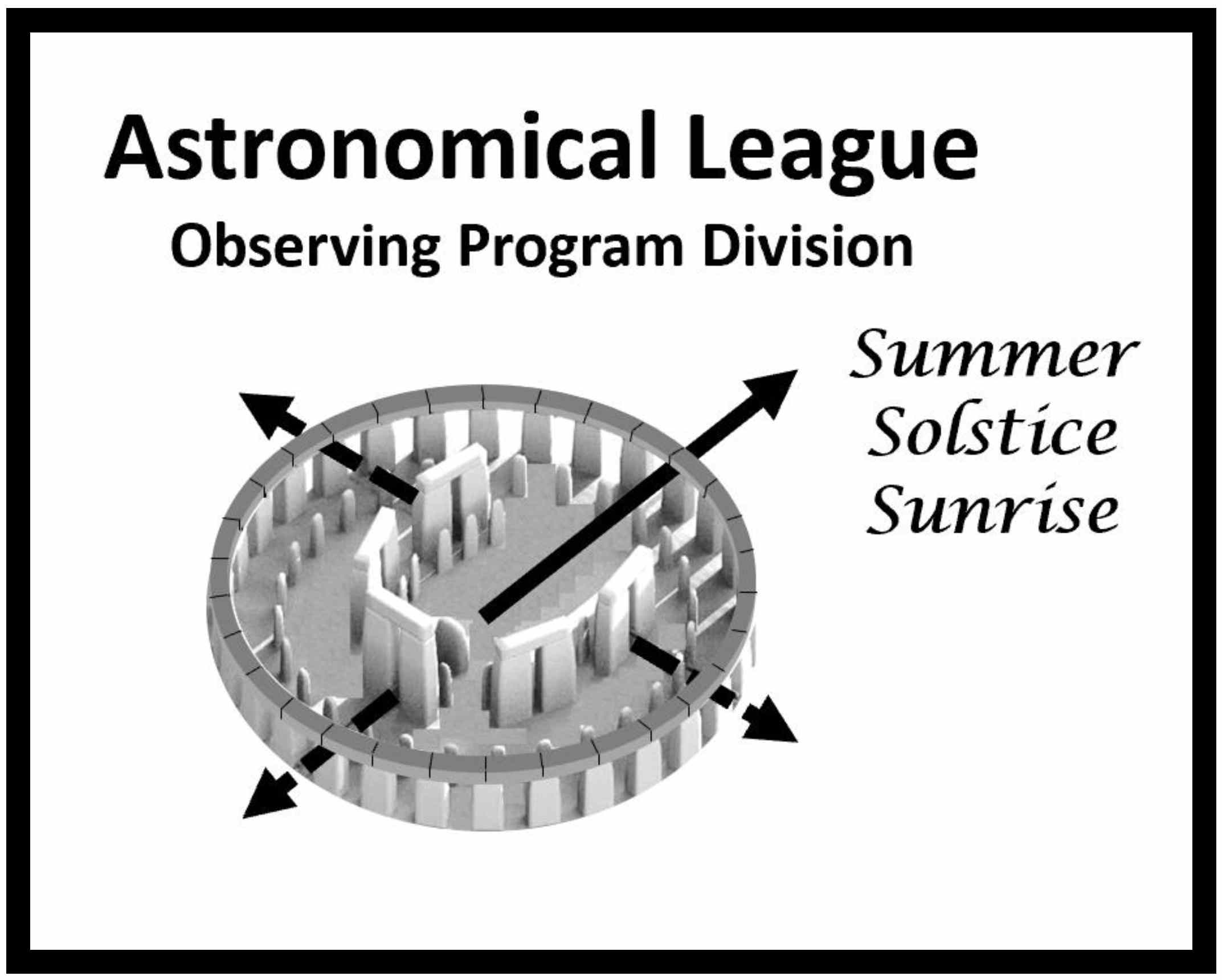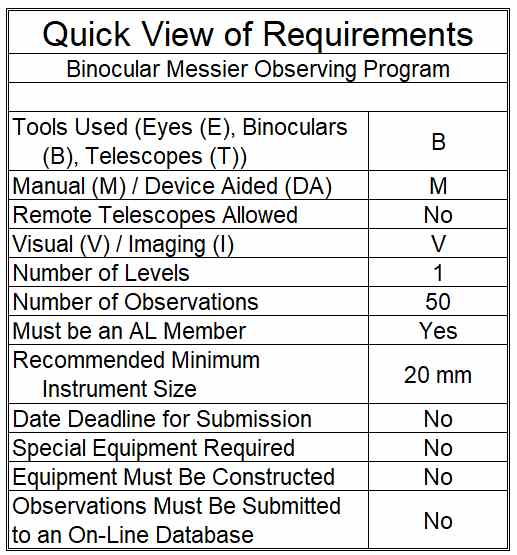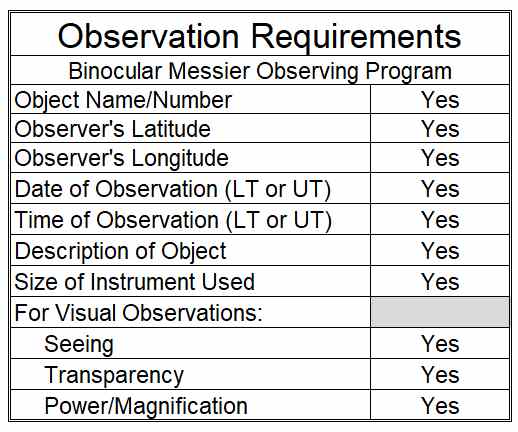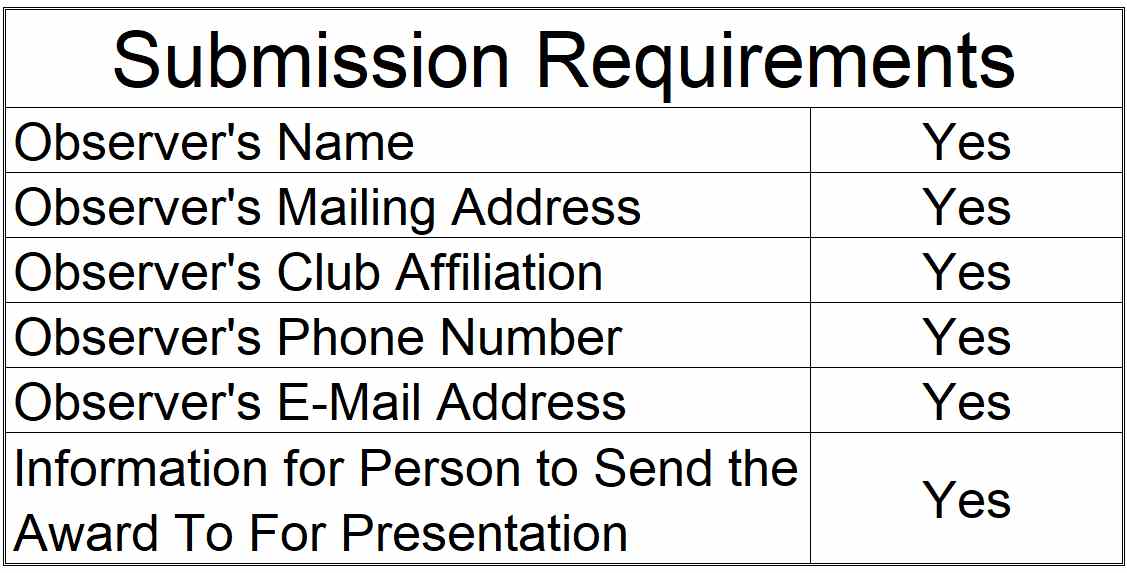Binocular Messier Observing Program Coordinator:John Goar |
  |
IntroductionThe Binocular Messier Observing Program is for beginning observers as well as experienced amateurs. Beginning observers will find that it doesn’t take an expensive telescope but only a simple pair of binoculars, no matter what size, cost or condition, to do serious astronomy. On the other hand, experienced amateurs, even though they may already have the Astronomical League’s telescopic Messier and Herschel certificates, will enjoy the new perspective binocular observing gives them as they pull back from an object and observe the area around that object as well as the object itself. Seeing the object and its relationship to the sky around it will put that object in its proper context in the sky. Requirements and RulesThis certification is available to members of the Astronomical League, either through their local astronomical society or as members at large. If you are not a member and would like to become one, check with your local astronomical society, search for a local society on the Astronomical League Website, or join as a Member-at-Large. |
 |
|
To qualify for the Binocular Messier Certification, observe 50 or more Messier objects using only binoculars. Any 50 of the 110 recognized Messier objects may be observed. Any pair of binoculars may be used, but those with objectives between 20MM and 80MM in diameter are recommended. To record your observations, you may use the log sheets found in the back of the Astronomical League’s manual “Observe: A Guide to the Messier Objects”, or any similar log sheet. The required information for each observation is:
|
 |
Definition of Binoculars Allowed for Observations
The Astronomical League defines a binocular telescope as an observing device with two optical tubes and two eyepieces, where the eyepieces can be replaced with eyepieces of different focal lengths. “Bino-Viewers” have a single optical tube, but two eyepieces. “Bino-Viewers” and Binocular Telescopes may be used in any Observing Programs that are telescope-based. They may not be used in binocular programs.
Observing devices with two optical tubes and two eyepieces, where you cannot change the eyepieces, are binoculars. Binoculars may be used in any Observing Program requiring telescopes or binoculars. Most binoculars do not have sufficient magnification to replace telescopes.
Submitting for Certification
| To receive your Binocular Messier Observing Program Certificate and pin, simply send your observations along with your name, mailing address, phone number, email address, society affiliation or Member at Large, and to whom the certification should be sent, to the Binocular Messier Observing Program Coordinator. |  |
Upon verification of your submission and of your active membership in the Astronomical League, your recognition (certificate, pin, etc.) will be sent to you or to the awards coordinator for your society, as you specified. Your name will also appear in an upcoming issue of the Reflector magazine and in the Astronomical League’s online database. Congratulations. Good luck with your next observing challenge.
Binocular Messier Observing Program Coordinator:John Goar |
Notes:
For those of you who are uncertain as to which Messier objects to observe, or who need a formal program to follow, we have included Appendix A and Appendix B for your use. Appendix A is for binoculars between 20MM and 50MM in diameter. Appendix B is for binoculars between 56MM and 100MM in diameter. Each appendix lists the appropriate Messier objects that can be observed with that size instrument and is divided into three categories: Easy, Tough, and Challenge objects. Easy objects are those that appear large and bright in the field of view and are easily observed. Tougher objects are small and dim in the field of view and require identifying the fields around them with the help of some sort of star chart to verify their location. Challenge objects are those that are small and faint, sometimes requiring averted vision, and need to be pinpointed exactly on a good star atlas to locate, identify, and observe.
You will notice that in the small binocular category (Appendix A), 42 objects are classified as easy. You need only choose 8 of the objects in the tougher category to receive your certification. For larger binoculars (Appendix B), all 50 objects needed to receive the certificate can be chosen out of the easy category. The point is that anyone, with any pair of binoculars, no matter what their size, shape, condition, or cost, can do serious astronomy, and acquire a Binocular Messier Observing Program certification. To prove that point, all 76 objects in Appendix A (Easy, Tough, and Challenge objects) were observed with a pair of 7×35 Tasco binoculars purchased at Walmart for $19.00.
Appendix C is for reference purposes, listing all 110 of the Messier objects at the times when they are best observed, and in constellation sequence. So, if you are wondering what is the best time of the year to observe a Messier object, refer to Appendix C. Appendix C tells you which season to observe each object, each object’s coordinates, their NGC numbers, the constellation they are located in, and their sizes and magnitudes. Also, Appendix C lists all of the Messier objects in the exact same order as the Astronomical League’s observing manual “Observe: A Guide to the Messier Objects”, in case you are using that as an observing aid.
I look forward to your sharing your binocular Messier observations with me. I think you will find that this is a worthwhile Observing Program that will not only give you a whole new perspective on the universe in which we live, but a more comfortable feeling for the night sky that we all enjoy so much. Good luck.
Clear skies, and good observing.
– John Goar



